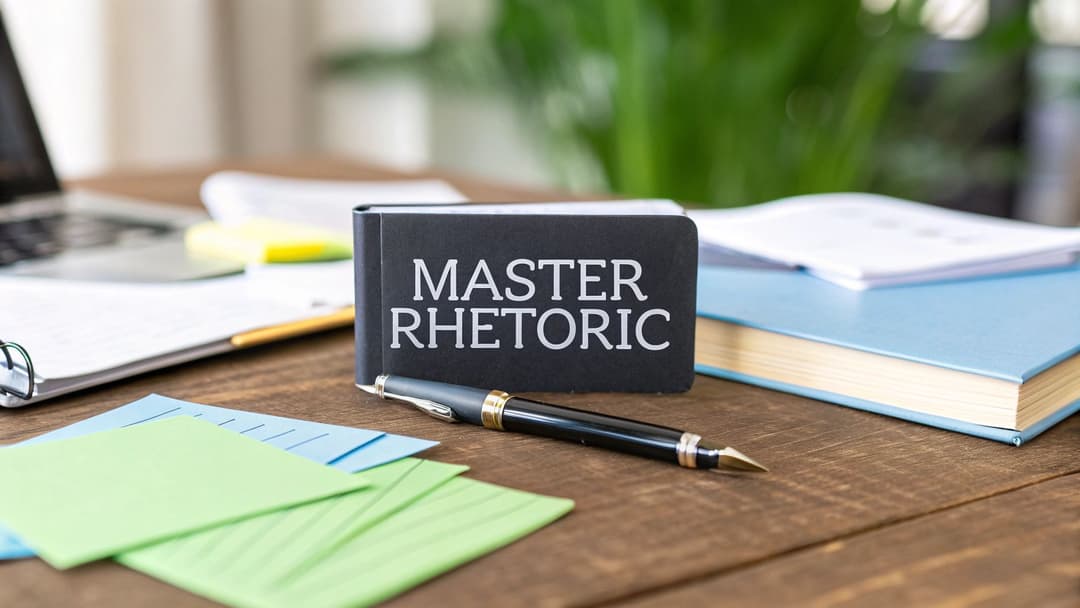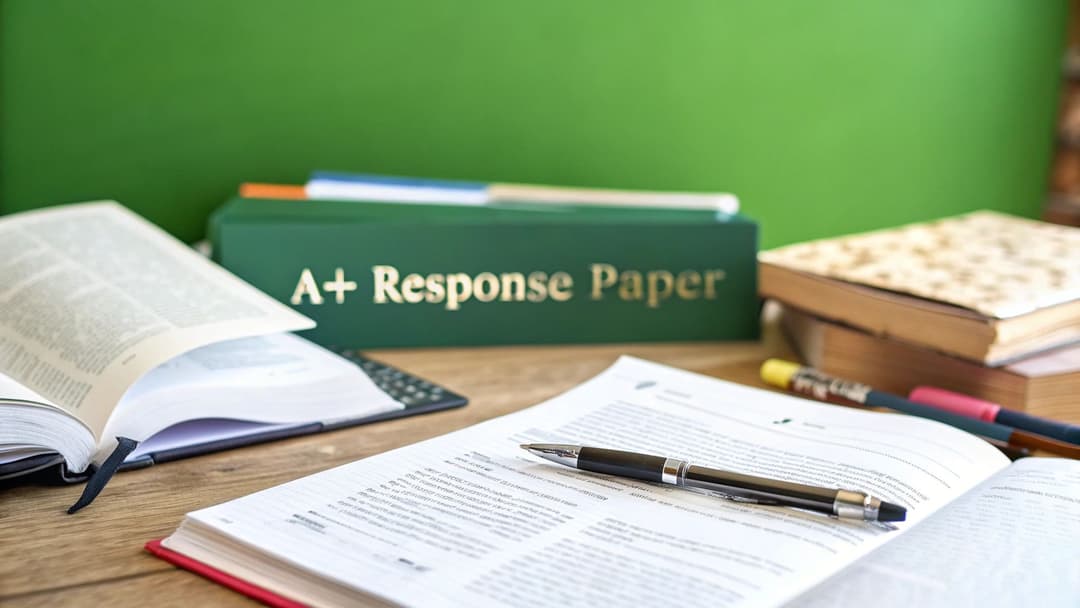
The OpenAI Text Classifier Explained
October 18, 2025
The OpenAI Text Classifier was a tool built to tell the difference between human-written and AI-generated text. It was created to get ahead of potential AI misuse, like automated misinformation campaigns, but was eventually shut down because of its low accuracy.
The Story Behind the Digital Detective
As generative AI tools started popping up everywhere, a new question emerged: how do you know if you're reading something written by a person or a machine? This sparked a massive debate in classrooms, newsrooms, and tech companies. OpenAI, being at the center of this shift, felt a responsibility to help find an answer.
Their solution was the OpenAI Text Classifier, a tool designed to be a kind of digital detective. Its whole job was to scan a piece of text and look for the subtle “fingerprints” an AI writer might leave behind. The hope was to give people—especially educators and content creators—a way to identify AI-generated content with some confidence.
The Problem It Aimed to Solve
The need for a tool like this came from some very real concerns about how powerful language models could be misused. The classifier was specifically built to tackle a few key issues:
- Academic Integrity: To help prevent students from passing off AI-generated essays as their own.
- Misinformation Campaigns: To spot automated bots spreading false or misleading information at scale.
- Content Authenticity: To help publishers and businesses make sure their content was original.
Basically, the classifier was an attempt to create a system of checks and balances. It was meant to bring some transparency to a world where the line between human and machine creativity was getting blurrier by the day.
The core idea wasn't to villainize AI content, but to give people a way to verify its origin. It was about knowing where a piece of text came from, just like you’d want to know the source of a news story.
The image below gives you a good sense of this role, showing the classifier as that "digital detective" looking for clues.
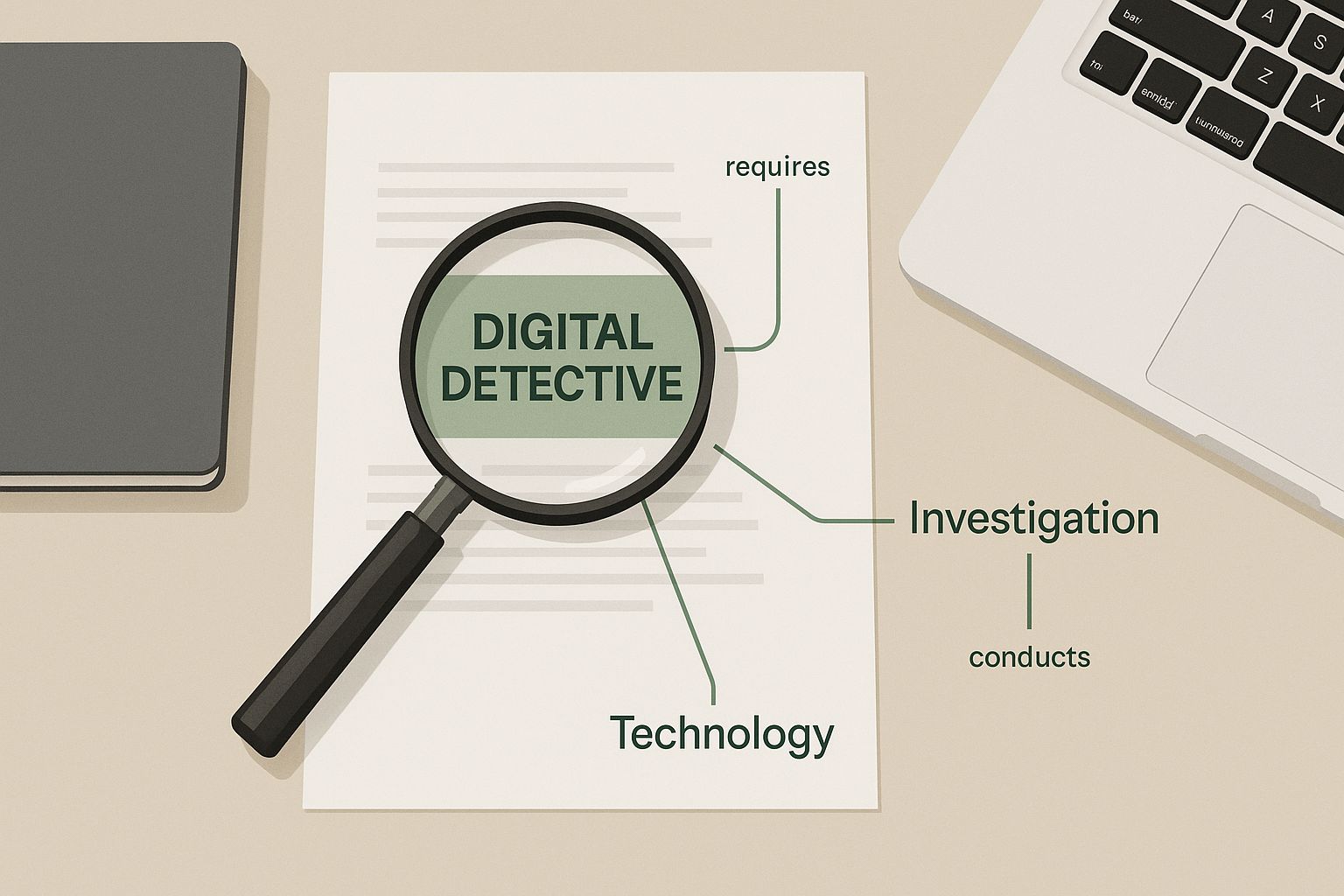
This detective work was critical, but right from the start, its effectiveness was pretty limited.
Why Ambition Met Reality
Despite its ambitious goals, the tool didn't last long. OpenAI launched the AI Text Classifier in January 2023 but pulled it offline just a few months later. The official reason? It just wasn't accurate enough.
This highlights just how tricky AI detection really is. The classifier was struggling to keep up with the very same technology it was supposed to monitor. As models like GPT-4 got better and better, their writing became almost indistinguishable from human writing. You can read the full story about why OpenAI shut down the AI classifier to get a deeper look at the technical challenges.
The decision drove home a hard truth: reliably telling the difference between high-quality AI text and human writing is an incredibly difficult job. It really set the stage for the ongoing cat-and-mouse game we see in AI detection today.
How AI Text Detection Actually Works
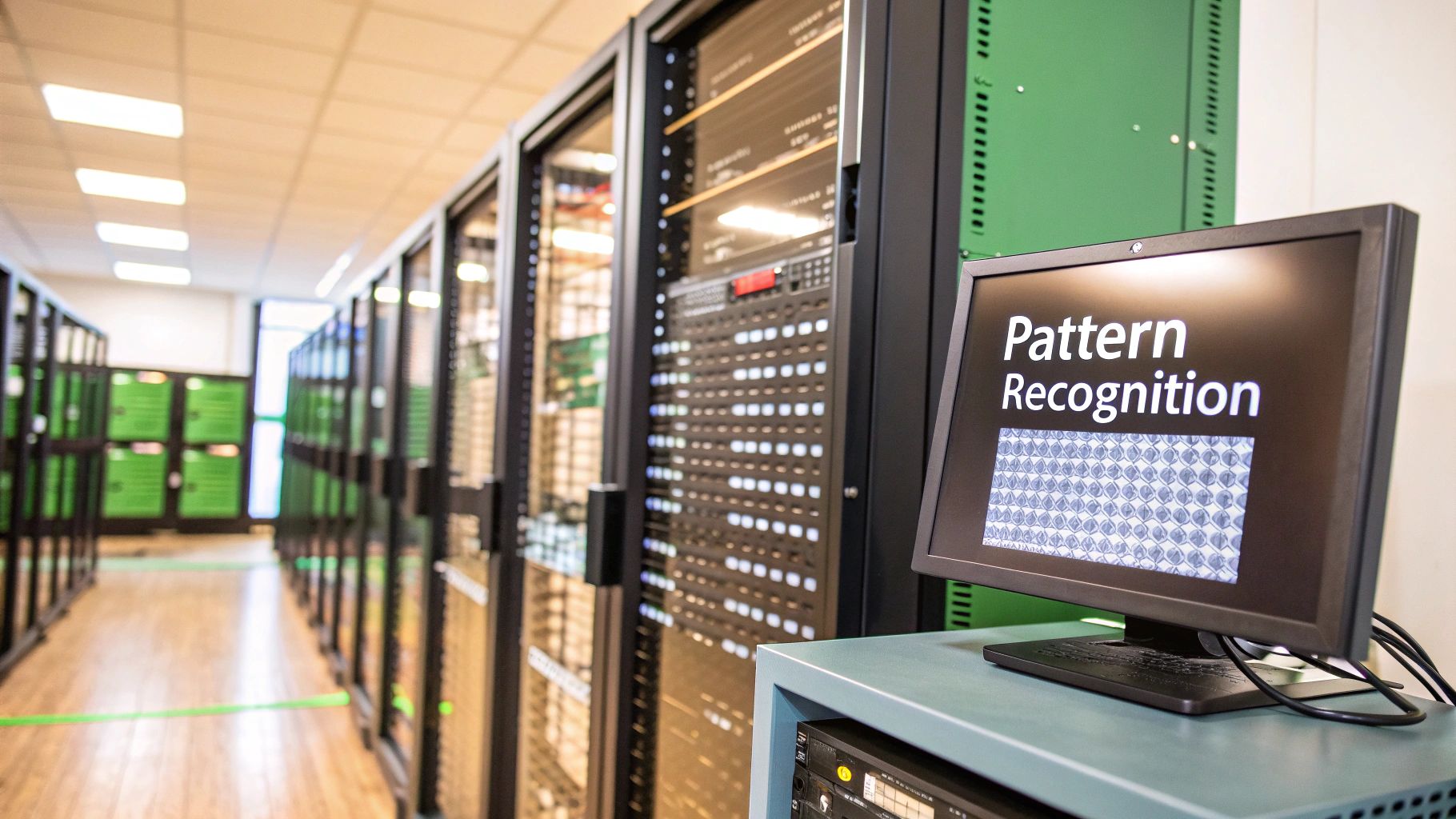
To get a feel for how a tool like the OpenAI Text Classifier used to work, it helps to stop thinking of it as a "reader." It was more like a statistician with a great ear for rhythm.
Imagine a music expert trained to spot the difference between a song composed by a human and one generated by an algorithm. The human composer might throw in some unexpected notes or creative pauses. The algorithm, on the other hand, is more likely to stick to perfectly predictable, mathematically sound progressions.
AI text detectors operate on a similar idea. They’re trained on gigantic datasets filled with millions of examples of both human-written and AI-generated text. From all that data, they learn to recognize the statistical patterns—the "fingerprints"—that give away who, or what, did the writing.
These detectors don’t care about meaning or emotion. They're looking at two key statistical properties: perplexity and burstiness.
The Clues of Perplexity and Burstiness
Perplexity is just a fancy way of measuring how predictable a piece of writing is. Human writing usually has higher perplexity because our vocabulary and sentence structures are all over the place. We might use a weird word or a slightly clunky phrase that a language model, trained to pick the most probable next word, would never choose.
Burstiness, meanwhile, is all about the rhythm and flow of sentence length. Humans write in bursts. We’ll follow a long, winding sentence with a short, punchy one for effect. AI models, especially the older ones, often produce text with a very uniform, even sentence structure that just feels unnaturally consistent.
High perplexity often points to a human author because it reflects the beautiful, unpredictable chaos of human thought. Low perplexity, in contrast, suggests the text follows a very logical, probable path—a dead giveaway of an AI model's predictive nature.
The classifier basically assigned a score based on these clues. If a text was too smooth, too predictable, and lacked the natural ebbs and flows of human expression, it was more likely to get flagged as AI-generated. You can find a deeper dive into these mechanics in our guide on how AI detectors work.
A Constant Cat-and-Mouse Game
The biggest problem for any OpenAI text classifier is that the AI models it’s trying to catch are always getting smarter. It’s a relentless cat-and-mouse game where the "mouse"—the language model—levels up with every new version.
This tech arms race is tied directly to the evolution of the GPT series. The journey from the early models to the powerhouse systems we have today shows exactly why detection is so hard. Starting with GPT-1 in 2018, which had 117 million parameters, and moving to the vastly more complex GPT-4, the AI's output has become almost indistinguishable from human writing.
- Early Models (like GPT-2): These were impressive for their time, but they had obvious tells. The text often felt repetitive, logically inconsistent, or just a bit "off," making it pretty easy for a classifier to spot.
- Intermediate Models (like GPT-3/3.5): This generation was a massive leap. The writing became far more coherent and natural. Catching it got much harder, depending on subtle statistical quirks that most people would never notice.
- Advanced Models (like GPT-4 and beyond): With these models, the game changed completely. They can mimic human writing styles with shocking accuracy, adapt their tone, and even introduce flaws on purpose to seem more human.
This lightning-fast improvement is precisely why OpenAI shut its own classifier down. The tool was built to spot patterns from a specific generation of AI, but the tech it was policing evolved right past its capabilities. Building a truly reliable detector requires constant retraining and adaptation—a challenge that has proven incredibly difficult for everyone in this space.
Why AI Classifiers Struggle with Accuracy
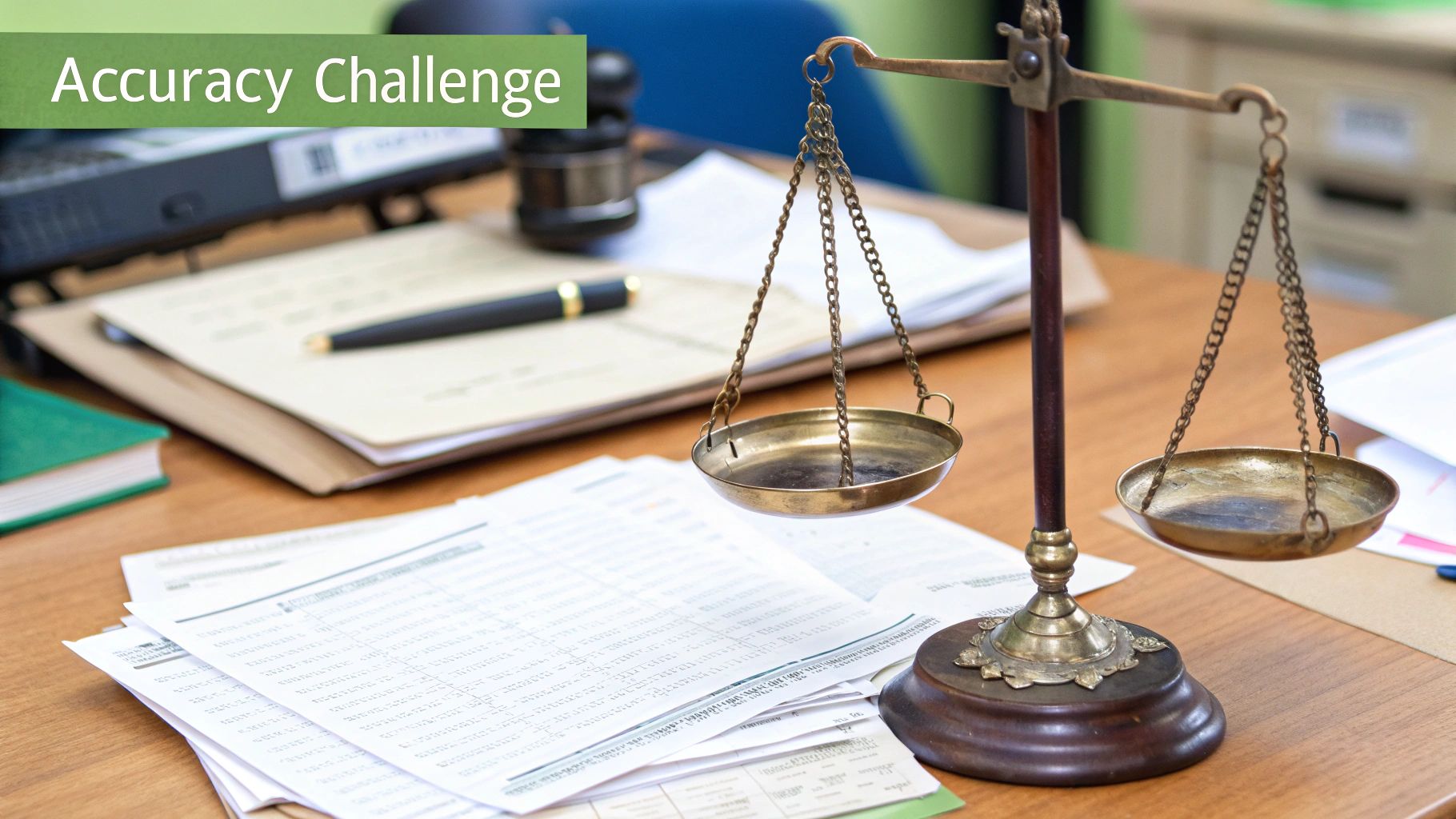
When OpenAI decided to pull its own text classifier, it wasn’t just a quiet update. It was a loud and clear admission: the technology just wasn't good enough. Despite everyone wanting a reliable AI detector, the tool's low accuracy was causing more problems than it solved, shining a spotlight on the deep-seated issues that plague all AI detection systems.
At the core of the problem were two massive errors: false positives and false negatives.
A false positive is when the tool screams "AI!" at something a human wrote. Imagine a student pouring weeks into an essay, only to get flagged for cheating by a faulty algorithm. The real-world fallout is serious, leading to unfair punishments and trashed reputations.
A false negative is the opposite—AI-generated text slips by completely undetected. This makes the tool pointless, letting automated spam or plagiarized content masquerade as genuine human work. OpenAI's own data was damning: the classifier only caught AI text correctly 26% of the time, while wrongly flagging human writing 9% of the time.
Where The Classifier Consistently Failed
The tool’s performance was especially bad in certain situations, where the messy reality of human language just didn't fit its rigid, pattern-based model. It stumbled badly when it was asked to analyze anything other than plain, long-form English.
Here’s where its weaknesses really showed:
- Short Texts: The classifier needed at least 1,000 characters to even try. Anything shorter was just a guess, as there wasn't enough data for it to find a reliable pattern.
- Non-Native English: People who speak English as a second language often build sentences in ways that can seem a bit formulaic to a machine. Their completely original, human writing was constantly getting mislabeled as AI-generated.
- Human-Edited AI Content: This was the easiest way to fool it. If someone used AI for a rough draft and then went in to add their own style, fix clunky phrases, and inject some personality, the AI's statistical "fingerprints" were completely wiped away.
This brings us to a critical truth: classifiers don't read for meaning. They just hunt for statistical patterns. When you disrupt those patterns—with short text, different linguistic styles, or a simple human touch—their accuracy completely falls apart.
The ethical mess this created was huge. In high-stakes fields like academia or journalism, a tool this unreliable is a liability. The risk of ruining someone's career over a machine's mistake was a big reason OpenAI shut it down. If you want to dive deeper into these issues, you can read our full guide on whether AI detectors actually work.
To put it in perspective, here's a quick look at where these tools hit or miss.
AI Classifier Performance Scenarios
| Scenario | Classifier Reliability | Reason for Performance |
|---|---|---|
| Raw, unedited AI output (long-form) | Relatively High | The text is full of predictable word choices and sentence structures that align with the AI's training data. |
| Short text snippets (under 1,000 characters) | Very Low | There isn't enough data for the classifier to find a statistically significant pattern. |
| Human-written text by non-native speakers | Low | Sentence structures can seem less complex to an algorithm, triggering false positives. |
| AI text heavily edited by a human | Very Low | Human editing introduces varied sentence structure, unique phrasing, and personal tone, erasing the AI's statistical signature. |
| Highly creative or poetic writing (human) | Low | Unconventional language and structure can confuse the classifier, which is trained on more standard text patterns. |
As you can see, the moment text deviates from the most basic, predictable patterns, a classifier's reliability plummets.
The Predictability Paradox
Here’s the irony: the very thing that makes language models like GPT-4 so effective is what detectors are built to catch. AI writing often has a certain smoothness and predictability because it's always calculating the most probable next word.
But the game is changing. Newer models are now being trained to introduce randomness, vary their sentence structures, and mimic the beautifully messy and unpredictable nature of human writing.
This creates a paradox for detectors. The better AI gets at sounding human, the worse tools like the OpenAI Text Classifier get at spotting it. It's a constant arms race, and right now, generative AI is always going to be one step ahead of the tools trying to police it. Flawless detection is looking more and more like a fantasy.
The Real-World Need for AI Detection
Even though the original OpenAI Text Classifier is gone, its short life wasn't a failure. Think of it as a flare sent up in the dark—it lit up a huge, and growing, need for reliable AI detection in just about every industry. When the tool was retired, the problem didn't go away. It just left a vacuum.
This need isn't some abstract concept; it pops up in real, high-stakes situations every single day. From classrooms to corporate boardrooms, the line between authentic human work and slick machine output is getting blurrier, and that's creating some serious headaches.
Upholding Integrity in Academia
Nowhere is this more urgent than in education. Picture a university professor buried under a stack of final essays. One paper is incredibly well-written, almost perfect, but it just doesn't sound like the student. It lacks their usual voice, their typical analytical style. The professor is stuck. Is this the student’s best-ever work, or a polished draft from a tool like ChatGPT?
Without a trustworthy way to check, the very foundation of academic integrity starts to crumble. This isn't about punishing students; it’s about protecting the value of learning how to think critically and form original arguments. Educators need tools to help guide students on how to use AI ethically, but that starts with being able to tell when a line has been crossed.
The challenge for educators isn't just about catching plagiarism. It's about ensuring that students are actually developing the skills they'll need for the future, rather than simply outsourcing their thinking to an algorithm.
The whole situation forces a tricky conversation about what "original work" even means in a world where AI is everywhere.
Ensuring Authenticity in the Creator Economy
The problem goes way beyond the classroom. Take a publisher who gets hundreds of manuscript submissions every week. It’s already a massive job to find the next great novel in that pile. Now, they have to worry that a big chunk of those submissions might be entirely AI-generated, completely missing any spark of human creativity or lived experience.
It’s the same story in the world of digital content, where authenticity is currency. Brands and media companies build trust with their audiences by creating unique, insightful content. If their blogs, articles, and marketing materials suddenly feel generic and machine-spun, that trust disappears fast.
The ripples of generative AI are felt across many sectors, and understanding various AI applications in digital marketing really highlights why being able to detect it is so critical. For these industries, AI detection is just another form of quality control.
- Publishing: Screening for AI-authored submissions to protect the value of human storytelling.
- Journalism: Verifying that news articles are written by actual reporters, not bots, to maintain credibility.
- Marketing: Making sure brand content has a genuine voice that connects with customers, instead of sounding robotic.
Without a reliable OpenAI text classifier or something similar, this whole screening process becomes a guessing game, forcing creators and publishers to rely on gut feelings alone.
Combating Misinformation at Scale
Maybe the most critical use for AI detection is in the fight against misinformation. Bad actors can now spin up thousands of fake news articles, social media posts, and online comments in minutes. These automated campaigns are scarily efficient at manipulating public opinion, sowing division, and spreading dangerous lies.
Imagine a social media platform trying to shut down a coordinated political disinformation campaign. Fleets of AI-powered bots can pump out convincing but totally false stories, overwhelming human moderators. A solid detection tool could act as a first line of defense, automatically flagging suspicious content before it goes viral.
Without this tech, platforms are stuck playing a never-ending game of whack-a-mole against a rising tide of automated propaganda. The need for a system to verify where text comes from has never been more obvious.
Adapting to a Post-Classifier World
With the official OpenAI text classifier gone, a big question hangs in the air: what now? For educators, creators, and leaders who wanted a simple detection tool, this new reality forces a major rethink.
The game isn't about finding a better AI detector anymore. It’s about fundamentally changing how we approach content in a world where AI writing is here to stay.
The gut reaction for many is to hunt for alternatives. Dozens of third-party AI detectors have popped up, all claiming impressive accuracy. But while some offer a general sense of things, they all share the same fatal flaws that led OpenAI to pull its own tool. They get tripped up by human-edited text, non-native English, and creative writing, making them just as likely to produce dangerous false positives.
Relying on these tools alone is like building a house on a shaky foundation. It's bound to fall apart. We need a smarter approach—one that gets beyond a simple "AI or not?" checkbox and leans into a more nuanced, skills-based evaluation.
From Detection to Critical Evaluation
Instead of asking if a machine wrote something, the better question is: Is this content any good? This shift from detection to critical evaluation is the only long-term strategy that makes sense. It’s all about developing human skills that algorithms just can't copy.
This means judging content on its quality, no matter where it came from. The new rubric should focus on things that automated systems still find incredibly difficult to master.
- Factual Accuracy: Is the information correct and can it be verified? AI models are notorious for "hallucinating" or confidently stating things that are completely false. Fact-checking is a human-driven task and remains the ultimate quality filter.
- Logical Depth and Nuance: Does the writing offer a unique perspective or deep analysis? AI is great at producing surface-level summaries, just spitting back common knowledge without adding any real insight. Great content explores the gray areas and connects ideas in fresh ways.
- Authorial Voice and Style: Does the writing have a personality? Human writing has its own unique rhythm, personal stories, and a distinct voice. AI text, on the other hand, often feels bland, overly formal, and just plain generic.
By focusing on these elements, you're not just trying to spot an AI; you're building a framework for demanding higher-quality content from everyone, whether human or machine-assisted. This approach raises the bar across the board.
For a teacher, this might mean creating assignments that require personal reflection or referencing specific in-class discussions. For a content manager, it means greenlighting articles that show genuine expertise and a unique brand voice over cookie-cutter, keyword-stuffed fluff.
The Rise of Humanized AI Text
As this new mindset takes hold, another trend is picking up speed: humanizing AI text. This isn't just about fooling detectors. It’s about using AI as a launchpad, then infusing the draft with the creativity, personality, and nuance that only a person can bring. Writers are evolving into expert editors, turning robotic drafts into something truly compelling.
This process involves a few key moves:
- Injecting Personal Stories: Weaving in a personal anecdote or a relevant case study instantly shatters the generic AI mold. It adds a layer of authenticity and makes the content relatable.
- Varying Sentence Structure: AI models often fall into repetitive sentence patterns. A human editor can break up that monotony, mixing short, punchy statements with longer, more detailed sentences to create an engaging rhythm.
- Refining Tone and Voice: A writer can tweak the tone to be more humorous, skeptical, or empathetic, aligning it perfectly with the audience. This is where the real art happens.
Tools like Natural Write are designed for this exact workflow. By spotting robotic text patterns and suggesting more natural phrasing, it helps writers bridge the gap between a raw AI draft and a polished, human-sounding final piece. It helps automate the cleanup, letting you focus on the important stuff—like adding unique insights and personal flair.
Ultimately, adapting to a world without a definitive OpenAI text classifier means we have to stop looking for a magic bullet. The line between human and AI writing is permanently blurred. Success now depends on our ability to champion what makes us human: critical thinking, deep expertise, and an authentic voice.
Common Questions About AI Text Classifiers
The original OpenAI Text Classifier may be gone, but its short life raised a lot of important questions that people are still asking. Understanding the answers is key to figuring out how to work in a world where the line between human and AI writing keeps getting blurrier. Let's tackle the big ones.
Why Did OpenAI Shut Down Its Classifier?
In a nutshell? Low accuracy. OpenAI pulled the plug on its AI Text Classifier in July 2023 because it just wasn't reliable enough. The tool couldn't confidently tell the difference between human and AI-generated text, especially as models like GPT-4 became more sophisticated.
It had some serious blind spots. The classifier was notoriously bad with short snippets of text, anything that had been edited by a human, or writing from non-native English speakers. This created a huge risk of "false positives" (flagging human work as AI) and "false negatives" (letting AI work slip through).
Realizing these mistakes could have serious, unfair consequences—especially for students—OpenAI took it offline. It was a clear sign of just how hard it is to build a perfect AI detector.
Can AI-Generated Content Be Made Undetectable?
Yes, most of the time. The process is often called "humanizing," and it involves a person taking an AI draft and adding the unique quirks and characteristics of human writing. This is way more than just a quick proofread.
A human editor can easily mask the text's origin by making a few key changes:
- Adding personal stories or specific examples an AI wouldn't know.
- Injecting a unique voice by mixing up sentence structures and breaking the monotonous rhythm you often see in AI drafts.
- Swapping out repetitive words and adding original opinions or insights.
As AI models get better at sounding human right from the start, even small edits are often enough to erase the statistical "fingerprints" that detectors search for. This makes it nearly impossible for even the best tools to tell the difference.
What Are the Best Alternatives to the OpenAI Tool?
While tools like GPTZero and Originality.ai have stepped in to fill the void, none of them are perfect. They suffer from the same fundamental problems that the original OpenAI text classifier had, and they should all be used with a healthy dose of skepticism.
A better approach is to stop focusing on detection and start focusing on evaluation. Instead of asking, "Was this written by an AI?" the more important question is, "Is this content valuable, accurate, and original?"
This new standard pushes for a deeper analysis that no algorithm can perform. It means fact-checking claims, judging the quality of the arguments, and looking for a unique perspective that actually adds something to the conversation.
For educators, this means creating assignments that demand critical thinking and personal reflection—things you can't just outsource to a machine. If you're in academia, it also helps to know how specific platforms work; for instance, you can learn more about if Turnitin can detect ChatGPT in our detailed guide. An evaluation-first mindset simply raises the bar for everyone, no matter who—or what—did the writing.
What Is the Future of AI Content Detection?
The future of AI detection won't be about a single magic tool. It’s moving toward a mix of smarter technology and a much bigger emphasis on human critical thinking. One of the most talked-about ideas on the tech side is digital watermarking.
With watermarking, AI models would embed an invisible, cryptographic signal directly into the text they create, making it easy to verify its origin. But this idea faces major hurdles, like getting the entire industry on board and the risk that savvy users could just strip the watermarks out.
Because of that, the long-term solution will almost certainly be a hybrid one. It will combine better tech like watermarking with a renewed push for media literacy—teaching people how to judge the quality, bias, and trustworthiness of information for themselves. It’s about giving us the skills to assess content on its own merits, whether a human or an AI wrote it.
Are you tired of your AI-generated drafts sounding robotic and getting flagged by detectors? Natural Write is your solution. Our free platform instantly transforms AI text into natural, human-like language, ensuring it bypasses detection tools like Turnitin and GPTZero. Stop worrying about robotic phrasing and start creating content with confidence. Humanize your writing in a single click at https://naturalwrite.com.
